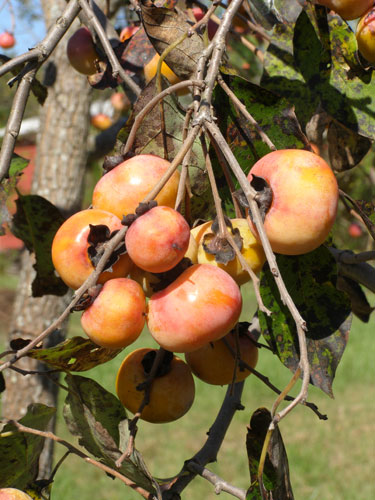Eulogy for Polk Place Persimmon
By Ken Moore
Flora columnist
Flora has annually eulogized the university’s 200-plus-year-old “Polk Place Persimmon.†Now, during what I lament may be its final year on that sacred ground, I’ve asked gardening friend and persimmon tree devotee Bill Bracey to take up the pen this time around.
Bill and I enjoy weekly evening sit-downs beneath his 100-plus-year-old persimmon tree. Never a week goes by that we don’t comment on our old friend, the Polk Place Persimmon.
And never a week goes by that I don’t express my admiration to Bill for having read all seven volumes of Marcel Proust, the master of the long sentence. I challenged Bill to honor the Polk Place Persimmon with a description as if composed by Proust himself. I tip my hat to Bill for having met that challenge, and am joyous to share with Flora readers this year’s annual eulogy to our ancient old tree friend by Bill Bracey.
“The common persimmon, Diospyros (fire, or fruit, of the gods), this tree had a good PR team, or perhaps the taxonomist was thinking of Bill Smith’s persimmon pudding, virginiana, is an outlier of the generally tropical ebony family, gracing the margins of our woodlands and standing sentry in fields and pastures, left there by farmers who valued the fruit provided at no cost and minimal labor other than that to collect it, and locally best exemplified by a remnant of the original campus forest, the magnificent dying specimen on Polk Place, delightfully defying the bland martial symmetry of the willow and white oaks that line the east and west perimeters of that southern quad of the UNC campus, but condemned by its location in a desert of bricks and mortar and the wide green lawns that are the polyester of landscapes (although I do appreciate their utility for outdoor spring classes and Ultimate Frisbee games) to a life of frustrating celibacy, as the dioecious persimmon takes two to, you know, and this beautiful male with the characteristic awkward branching habit (which gave its kind a darker utility as a hanging tree) under which one spring not long ago I stood for one oneiric hour, captivated by the faintly audible rain of white bell-shaped flowers in a waning show of potential fecundity before any visible signs of the tree’s decline had registered, with branches fully leafed and distinctive deeply furrowed bark sturdy enough for a child to free-climb, this tree that lived its latter years in one hand clapping will soon leave the campus to lesser but more productive kin including the one just off the lanes Battle & Hooper, a civilly unioned female that each fall is laden with more golden-orange fruit than seems possible, which after ripening to the point of losing the astringency that defines astringency, and falling to the ground, is as sweet as any candy and a reason to steer any autumn amble beneath its branches, all the more as we are losing the patriarch of Polk Place, one of the last biological natural features that all the Carolina family have shared.
So, long live the Davie Poplar and what is left of the Noble Grove.â€

Don't dare taste persimmon fruit until it is golden-orange and soft to the touch! Photo by Ken Moore

A female persimmon flower depends on pollen from a male tree to produce fruit. Photo by Betsy Green Moyer
Email Ken Moore at flora@carrborocitizen.com. Find previous Ken Moore Citizen columns at The Annotated Flora (carrborocitizen.com/flora).




Comments are closed.